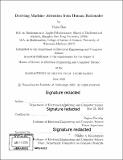| dc.contributor.advisor | Regina Barzilay. | en_US |
| dc.contributor.author | Bao, Yujia. | en_US |
| dc.contributor.other | Massachusetts Institute of Technology. Department of Electrical Engineering and Computer Science. | en_US |
| dc.date.accessioned | 2019-11-12T17:41:08Z | |
| dc.date.available | 2019-11-12T17:41:08Z | |
| dc.date.copyright | 2019 | en_US |
| dc.date.issued | 2019 | en_US |
| dc.identifier.uri | https://hdl.handle.net/1721.1/122878 | |
| dc.description | Thesis: S.M., Massachusetts Institute of Technology, Department of Electrical Engineering and Computer Science, 2019 | en_US |
| dc.description | Cataloged from PDF version of thesis. | en_US |
| dc.description | Includes bibliographical references (pages 47-50). | en_US |
| dc.description.abstract | Attention-based models are successful when trained on large amounts of data. In this thesis, we demonstrate that even in the low-resource scenario, attention can be learned effectively. To this end, we start with discrete human-annotated rationales and map them into continuous attention. Our central hypothesis is that this mapping is general across domains, and thus can be transferred from resource-rich domains to low-resource ones. Our model jointly learns a domain-invariant representation and induces the desired mapping between rationales and attention. Our empirical results validate this hypothesis and show that our approach delivers significant gains over state-of-the-art baselines, yielding over 15% average error reduction on benchmark datasets. Our code and data are available at https: //github. com/YujiaBao/R2A. | en_US |
| dc.description.statementofresponsibility | by Yujia Bao. | en_US |
| dc.format.extent | 50 pages | en_US |
| dc.language.iso | eng | en_US |
| dc.publisher | Massachusetts Institute of Technology | en_US |
| dc.rights | MIT theses are protected by copyright. They may be viewed, downloaded, or printed from this source but further reproduction or distribution in any format is prohibited without written permission. | en_US |
| dc.rights.uri | http://dspace.mit.edu/handle/1721.1/7582 | en_US |
| dc.subject | Electrical Engineering and Computer Science. | en_US |
| dc.title | Deriving machine attention from human rationales | en_US |
| dc.type | Thesis | en_US |
| dc.description.degree | S.M. | en_US |
| dc.contributor.department | Massachusetts Institute of Technology. Department of Electrical Engineering and Computer Science | en_US |
| dc.identifier.oclc | 1126661737 | en_US |
| dc.description.collection | S.M. Massachusetts Institute of Technology, Department of Electrical Engineering and Computer Science | en_US |
| dspace.imported | 2019-11-12T17:41:07Z | en_US |
| mit.thesis.degree | Master | en_US |
| mit.thesis.department | EECS | en_US |
